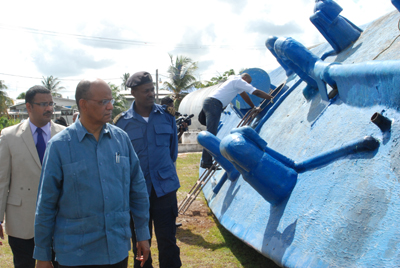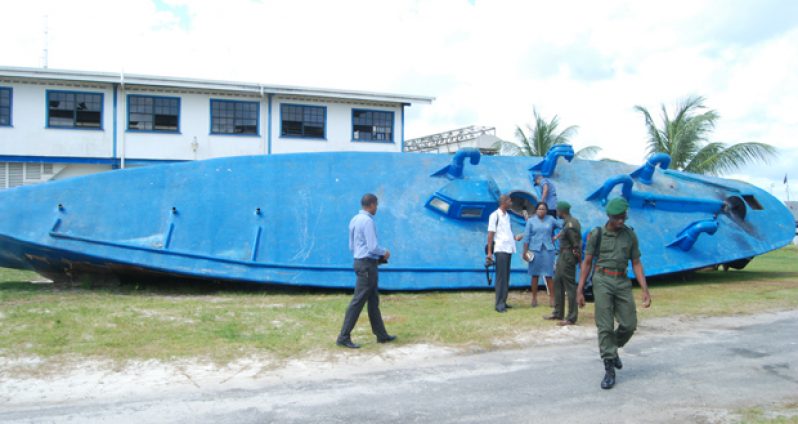-several questioned by CANU, investigations ongoing
WHILE the national, regional and global fight against the drug trade is one that may never end, the interception of a Self-Propelled Semi-Submersible (SPSS) vessel last month will send a strong signal to drug traffickers, both in and out of Guyana, that law enforcement agencies are on the alert and are very active.This is according to Minister of Home Affairs, Clement Rohee who inspected the 63-foot , 18-tonne vessel yesterday at the Guyana Defence Force Coast Guard Base at Ruimveldt.

The SPSS vessel was discovered at a camp site in Waini River, North West District, Region 1, last month, following an intelligence-driven joint operation conducted by the Customs Anti-Narcotic Unit and the GDF’s Special Forces, Coast Guard and Air Corps.
The vessel has a capacity to accommodate a crew of about four to five people and four to six tonnes of cocaine.
Minister Rohee commended the law enforcement ranks who were part of the operation and said that this is a good example of inter-agency cooperation. The resources at the disposal of the armed forces are limited especially, and as such, more cooperation and consolidation of efforts is encouraged.
The discovery of a SPSS of this kind is not peculiar to Guyana, as similar vessels have been found in many parts of Latin America. At the request of the Government, experts from the US Drug Enforcement Agency (DEA) were deployed to assist local law enforcement agencies to get a better understanding of the technical capabilities of a vessel of this nature.

From a geo-strategic perspective, Guyana is seen by traffickers in many countries as an ideal transshipment point. Minister Rohee said that the Administration has to continue to ensure that law enforcement agencies are provided with the necessary wherewithal to fight this global scourge.
Earlier this year, the marine wing of the GDF received three metal shark patrol boats from the US Government, under the Caribbean Basin Security Initiative (CBSI). The Guyana Revenue Authority (GRA) has also procured vessels, while the Guyana Police Force is currently in the process of improving capacity to conduct waterway patrols and surveillance.
Minister Rohee reminded of the GPF’s strategic plan (currently being implemented) which speaks to the issue of more training of ranks and overall enhancement of the marine sector of the Force.
“Drug traffickers use rivers, waterways and territorial sea very frequently to conduct their nefarious activities…we hope that this kind of work will continue on the part of the law enforcement agencies with the help of the GDF,” the Minister said.
Members of the Task Force on Narcotic Drugs and Illegal Firearms, headed by Major General (rtd) Michael Atherly, were also present to get a firsthand look at the vessel. This task force recently completed the final draft of the country’s new National Drug Strategy Master Plan which has since been presented to the Cabinet for its approval.
This plan outlines the strategic, tactical and institutional objectives of the Government for the 2013-2017 period, with regard to the fight against drug trafficking. Once it is approved (with possible amendments from the Cabinet), funding will have to be secured for its implementation.
Meanwhile, CANU’s Head, James Singh, said that thus far seven persons have been questioned in connection with the SPSS vessel and investigations are still ongoing.
“These semi-submersible vessels are built for one reason and one reason only, and that is to transport drugs, mainly cocaine. This vessel was more than likely going to Europe or Africa, not the U.S.…the camp itself has been there for at least five months based on the materials found,” Singh said.
The odometer reading revealed that the vessel travelled for only three hours and that includes a test run conducted in the Waini River by the law enforcement agencies to see the maximum speed.
The top speed of the vessel, when empty, is about 10-12 knots, while, when fully laden, it has an average speed is six to eight knots.
This information, along with other evidence found at the camp site, has led investigators to convincingly conclude that the vessel was constructed in Guyana. The fuel and fiber glass material of which the vessel is made were all imported from another country, only the foodstuff found at the camp site was local.
“This is based on us sharing information with experts, persons who have seized vessels like this before… this now moves us beyond just transshipment,” Singh said.
The vessel was found in mid August hidden away in a swamp, and was transported on a barge to Georgetown, where it was hoisted by a crane unto a low-bed trailer, then brought in to the Coast Guard Base in Ruimveldt.
(GINA)




.png)









